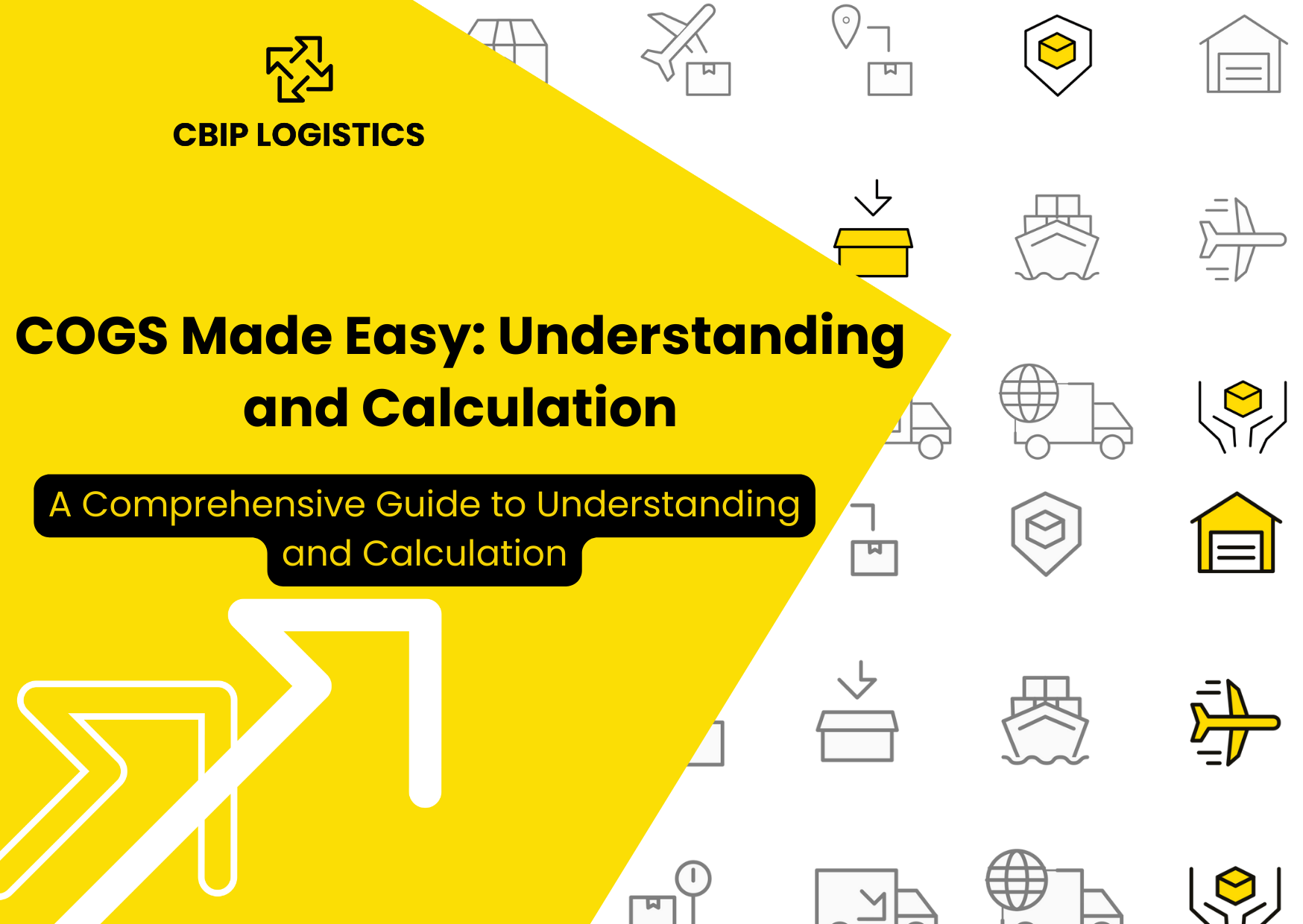COGS Made Easy: Understanding and Calculation for E-Commerce Retailers

The other day, I decided to enjoy my time off by heading over to my favorite coffee shop. However, I was a bit let down when they told me they'd run out of my favorite coffee.
That got me thinking about how important good inventory management is for avoiding stockouts and keeping customers happy. Managing inventory is like a balancing act. You don't want to have too much stuff sitting around because that ties up your money, but you also don't want to run out of products and frustrate your customers. It's all about managing inventory properly to find that sweet spot.
The foundation of good inventory management all starts with four words: Cost of Goods Sold (COGS). In essence, COGS is a formula using your starting inventory, goods sold, and ending inventory, to figure out what you’ve sold in a fiscal period.
However, COGS is more than just a simple formula. COGS affects things like how much inventory you should keep on hand, when to reorder, and even your profit margins.
Even though you may use an accountant to track your balance sheet, understanding COGS is crucial for DTC brand owners. Understanding your balance sheet allows you to make smarter decisions about inventory, and gives you the knowledge you need to make long-term decisons for your business.
Today, I want to answer some common questions that retailers have about COGS, like:
Q1. What is the Cost of Goods Sold (COGS)?
Q2. How is COGS calculated?
Q3. What are the typical methods for calculating COGS?
Q4. Why is it essential to factor in COGS for your business?
Q1. What is the Cost of Goods Sold (COGS)?
In order to understand what COGS includes, we first need to discuss two types of costs. When we talk about the cost of producing and delivering goods, there are two categories:
Direct costs and indirect costs.
Examples of a direct cost include:
- Manufacturing expenses
- Direct labor
- Direct materials
- Freight and shipping
- Fulfillment costs (*)
While an indirect cost would be:
- Marketing expenses
- Distribution expenses
- Administrative expenses
- Rent
- Management salaries
- Fulfillment costs (*)
The Cost of Goods Sold (COGS) pertains to the direct cost category It encompasses costs that are directly linked to the goods being sold and can fluctuate depending on the volume of units sold. In calculating COGS, indirect expenses are excluded from the equation.
It's worth noting that the specific components of COGS can vary depending on the nature of your business. Regarding fulfillment costs (*), whether they fall into the category of direct or indirect expenses hinges on how you allocate them and the nature of your business operations. Here's a general guideline:
Direct Cost: If your fulfillment costs are assessed on a per-order or per-unit basis, such as a fixed fee per item or a pick-and-pack fee, they should be classified as direct costs. These costs can be directly attributed to individual orders and may fluctuate in accordance with the number of units sold.
Indirect Cost: If your fulfillment costs are not directly tied to individual orders or units but instead constitute general operational expenses, they should be categorized as indirect costs. This category encompasses expenditures like warehousing fees, inventory management, and ongoing charges for utilizing third-party logistics (3PL) services.
Ultimately, as a DTC brand, the manner in which you manage these cost allocations is contingent on your specific circumstances and business requirements.
Q2. How is COGS calculated?
To compute your Cost of Goods Sold (COGS), you'll need to combine your initial inventory and your inventory purchases, and then subtract your ending inventory from the total. The formula can be represented as follows:
COGS = Starting Inventory + Purchases - Ending Inventory
Now that you have your neat little formula, you need to figure out what values to input for your business. Here are the four steps.
Step 1: Establish your starting inventory
For newly established businesses, the starting inventory is typically zero.
If you are an experienced retailer with inventory on-hand, you’ll need to tally up the total value of what you’ve got.
Step 2: Determine Your Purchases
Depending on the nature of your business, whether you manufacture the products yourself or outsource them under a private label, most Ecommerce Entrepreneurs opt for a private label.
Step 3: Calculate Your Ending Inventory
The ending inventory is the stock that remains at the close of the accounting period.
This inventory often carries over to the next accounting period, forming the basis for your starting inventory for that period. However, you might choose to dispose of it at a lower, zero, or even negative margin, whether through sales, charitable donations, or considering it as waste.
To calculate the ending inventory, subtract the inventory sold during the period from the beginning inventory plus purchases.
Step 4: Apply the COGS Formula
Allow me to illustrate with an example:
I operate a business specializing in music boxes. I placed an order with a factory in Thailand for goods valued at $40,000. As of the end of Q1/2023, my inventory at the 3PL's fulfillment center is valued at $10,000. Therefore, my quarterly COGS can be calculated as follows:
COGS = Starting Inventory + Purchases - Ending Inventory
COGS = $0 + $40,000 - $10,000
COGS = $30,000
Q3. What are the typical methods for calculating COGS?
At this point you may be wondering; what number should I use for the value of ending inventory? Well, in order to figure out the number, you (or your accountant) first have a decision to make about which accounting method you want to use.
The FIFO, LIFO, and WAC accounting methods all have their own advantages and drawbacks. Typically, the two big determiners are:
A. How do you want to be taxed at the end of the fiscal year?
and
B. What type of goods are you selling?
To help you see what I mean, let’s dive into each of the methods.
FIFO (FIrst In First Out)
FIFO operates on the principle that the first goods purchased or produced are the first to be sold. In essence, it means that the oldest inventory is the first to leave the warehouse and be shipped to customers.
Under this method, even if there have been recent changes in the cost of inventory, the cost of the oldest inventory is used to calculate the value of the ending inventory.
Let's revisit the music box business example. In the first quarter, you initially purchased 1,000 music boxes at a cost of $30 per unit. Later in the same quarter, you decided to acquire an additional 900 music boxes at a cost of $35 each. Over the quarter, you sold 1,100 music boxes. Using the FIFO method, your COGS would be calculated as follows:
COGS = (1,000 x $30) + (100 x $35)
COGS = $30,000 + $3,500
COGS = $33,500
Since prices typically increase over time, often due to factors like inflation, a business using the FIFO method typically sells its least expensive products first. In the long run, this practice reduces its COGS and increases its net income.
It’s also usually the best method of valuation for retailers selling perishable goods, as FIFO can help you more efficiently move stock in and out of your warehouse, avoiding spoilage.
LIFO (Last-In, First-Out)
The LIFO method operates on the premise that the most recently purchased or produced goods are the first to be sold. Consequently, it considers the most expensive inventory as the first to be sold, resulting in a higher COGS and, consequently, a lower net income.
This method is typically most favorable to those looking to lower their end-of-fiscal-year taxable income, but it is not legal in every country.
WAC (Weighted Average Cost)
The WAC method calculates COGS by determining a weighted average of all goods in stock, without taking into account the specific date of production or purchase.
This method considers the quantities and costs of all inventory items, assigning a weighted average cost to calculate COGS. As a result, it is less susceptible to the influence of cost fluctuations over time.
Each of these methods carries its own implications for inventory valuation and COGS calculation. Your accountant will make the determination of the most appropriate method to use based on your specific business requirements and the regulations in your jurisdiction.
Q4. Why is it essential to factor in COGS for your business?
The Cost of Goods Sold (COGS) is a crucial metric for DTC brands, and it's essential to grasp its significance for these key reasons:
Financial Health
COGS helps you assess your DTC brand's profitability. By calculating it accurately, you can figure out how effectively you're turning your resources into revenue.
Pricing Strategy
Knowing the direct costs of your products aids in setting competitive and profitable prices. This ensures you cover costs and make a reasonable profit.
Inventory Control
COGS is closely tied to inventory management. It helps you track inventory value, make smart decisions about stock levels, and manage the supply chain. Accurate COGS calculations optimize inventory turnover, prevent overstocking or running out of stock, and reduce holding costs.
Financial Reporting
COGS is vital for financial statements, like the income statement and balance sheet. It provides a clear picture of costs associated with sold goods, ensuring accurate financial reporting.
However, remember that COGS has its limits. It may not consider all inventory changes, such as losses or donations. To maintain accurate COGS, keep good records and conduct regular inventory counts.
Also, be watchful for any potential COGS manipulation, like altering manufacturing costs or misrepresenting inventory values. Use controls and audits to protect against such practices.
Final Thoughts
As you've explored COGS, you've seen how important costs are for your business. But not all logistics companies truly understand these costs, especially when it comes to logistics.
In this crowded market, CBIP is the partner you can rely on. Our team of experts is ready to provide the logistics support your brand needs. We're more than just logistics; we're your strategic logistics partner. If you're ready to improve your supply chain and boost your brand's success, we're here for you. Schedule a meeting with us today and together, we can take your business to the next level.
Thank you for reading, and I eagerly anticipate connecting with you again in our next blog!
Thao Nguyen
Sales & Marketing Manager






